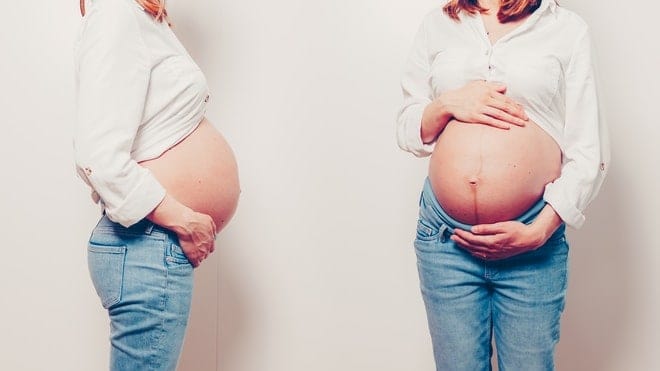The most unexpected things can happen after you undergo a C-section, especially more so if this is your first. One of the common issues is suffering from rashes. So why do you develop a rash on the stomach after your C-section procedure?

A rash after a C-section might show up because of different reasons, including contact dermatitis from the surgical staples, cellulitis, or as a response to allergic reactions from the narcotics administered for pain management. The good news is that most of the causes of these rashes shouldn’t be a cause for worry.
When you notice a rash after your Cesarean section, you can call your doctor as soon as possible to help lessen your discomfort.
Here are the most common causes of rash formation on the stomach:
Allergic Reaction
Allergic reactions are the most common causes of rashes on the stomach after a C-section. There are instances when the rash develops on your tummy even when it is because of medication, like the specific pain medication given to you after the procedure.
It is also possible that you are experiencing allergic reactions to the specific cleaning solution used after or before the surgery. They often use more than water and soap alone, and there are instances when your body may not have a good reaction to this.
If this is your first-time undergoing a Cesarean section, you might also be sensitive to the specific solution used for disinfection and you might not be aware of it yet.
If this is the cause of your rash after your Cesarean section, you will notice that this rash is often rectangular in shape in the spot where the solution was applied. Steroids may help clear up the rash.
Hives
A lot of things can actually cause hives, and one of these is stress. If you have an itchy rash and it resembles hives, it probably is.
Many doctors recommend the use of Benadryl to address this problem. Benadryl can help with that itchy feeling and make you feel more comfortable until all the hives are gone.
Hormonal Imbalances
Your body will start the course of going back to normal after your C-section. It includes a roller coaster of emotions that are the result of your hormones trying to balance out themselves.
But it may take some time before the hormones get back to their pre-pregnancy levels. You will notice that you have most of the symptoms of hormonal imbalance such as those you experienced during pregnancy.
It can affect your immune system as well. While you have never suffered from allergies in the past, things such as pollen and dust might bother you all of a sudden.
While your body adjusts to the changes, it becomes more sensitive to things around you, such as the laundry soap you are using. This is the reason why postpartum hives are often considered normal.
Infection
Even if doctors are extra careful to make sure that everything is sterilized, there will always be the possibility of suffering from an infection.
You can identify it easily when the area feels warm when touched, there is abnormal drainage at the incision’s location, possible chills, and fever. Once you noticed any of the said symptoms, it is important that you call your doctor immediately.
Scratching
Do you have a bad habit of always scratching everything that itches in your sleep, including your stomach? If yes, then, you might wake up the next morning with the whole area looking reddish.
If your tummy feels very itchy, which is common when it heals, you have to monitor the spot to ensure that it is really a rash instead of just looking red because of scratching.
PUPPP
Pruritic urticarial papules and plaques of pregnancy or PUPPP is a condition best characterized by the itchy rash that comes with it. This is also the very first thing that most people think of when they experience a rash.
However, PUPPP occurs only during your first pregnancy and for most women, it happens while they are still pregnant.
PUPPP cases rarely occur in postpartum women. There are women who report that the rash started shortly before they give birth that continued while they were postpartum.
There are also others who reported that their PUPPP rash didn’t start until after they delivered their baby.
The following are other PUPPP symptoms to watch out for:
- It spreads fast and it may only take 2 to 3 days for it to spread to extremities.
- The rash resembles tiny pink pimples.
- The rash looks like hives when the rash begins to spread to the extent that it combines together.
- The rash begins inside the stretch marks.
- PUPPP doesn’t pose any harm for both you and your baby. There are also no long-term effects that you should worry about.
Treatments for PUPPP often include steroid creams, anti-itch creams, and home remedies to make the condition more tolerable. The real cause of PUPPP remains unclear so many treatments only aim to make you feel more comfortable.
What to Put on Your C-Section Scar to Prevent Rash and Itching?
Itching is usually a part of the process of healing following a C-section procedure. However, you can try to reduce the severity of the itchy feeling. You can encourage healthy healing of the skin by drinking lots of water and sticking to a diet rich in nutrients.
You also have to make sure that the incision site is always clean to lessen the risks of infection and inflammation. Avoid wearing any clothes that might irritate the C-section area like polyester or nylon.
When the area gets itchy, there are women who discovered that putting an ice pack over the spot for 5 to 10 minutes can help calm the sensation.
So far, there are still mixed thoughts on whether you should apply gels or topical creams for itching on C-section incisions. There are medical professionals who think that it doesn’t hurt but there are others who firmly believe that it is better to just leave the wound alone. Make sure you consult your doctor before you use or apply anything directly on the healing incision.











